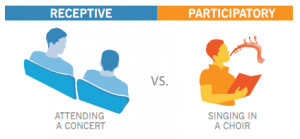One of the interesting topics that came up during the Q&A session at Sunday’s event was how arts organizations can engage communities through participatory experiences. Rather than sit and passively watch a concert, people seem to increasingly prefer doing the playing and singing themselves. Certainly the eye-popping success of the YouTube Symphony shows there’s an appetite for hands-on participation in the orchestral world. Does the role of the orchestra in its community need to change accordingly?
A recent study, sponsored by The James Irvine Foundation and conducted by WolfBrown, examines this trend:
Arts participation is being redefined as people increasingly choose to engage with art in new, more active and expressive ways. This compelling trend carries profound implications, and fresh opportunities, for a nonprofit arts sector exploring how to adapt to demographic and technological changes.
Read the full WolfBrown report.
I find this to be such an interesting comparison to where we were a hundred years ago, when live music was ubiquitous in our culture. From cafe orchestras to park bands to the piano in your living room — live music was everywhere. It’s a point Neil Harris made in his Spotlight Conversation. Certainly technology will allow us to participate in entirely new ways, but the impulse to create music remains the same.
The report cites a few specific examples of orchestras that have launched community music-making projects.
- Baltimore Symphony – Rusty Musicians
- Chicago Symphony – Citizen Musician
- Pacific Symphony – All We Do is Play
- San Francisco Symphony – Community of Music Makers
If you’ve come across others, we’d love to hear about them in the comments.




Certainly, we want to encourage people, esp. kids to make their own music. It’s great to reawaken in adults what music training they have had, esp. if we can help them rent or buy affordable instruments. However, from my seat, many or NOT shy about learning instruments even as adults IF those instruments are for a music in which they feel deeply, emotionally invested. Many adults take up folk or electric guitars, bass guitar, saxophone, drums, congas or singing. Around classical music, the intimidation factor is VERY high.
Perhaps to lower that, our orchestras could offer instrument “petting” FOR ADULTS around concerts! The local Suzuki studio could bring teachers to offer on the spot public lessons in the lobby before or after concerts. Sign them up for group lessons with a rental package.
As far as singing, there’s nothing Americans love to do more! If the concert hall is to be the new church, offering spiritual experiences, orchestras could offer a community choir OF TICKET BUYERS who come to sing and know some Italian, German, Xhosa, whatever. They could do an annual concert with orchestra members and truly feel a PART of the orchestra. More individually, isn’t there a CLASSICAL karaoke yet? Have a weekly experience around food and drink. People like to show what they know. Facilitate! Again, it is NOT either-or, rather both-and.
That said, there are many ways to engage a seated audience too… more than a welcome and having the performers bow.